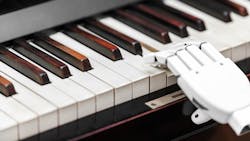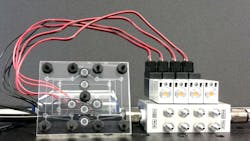If pneumatic technology is associated with high force and speed, electronic actuators conjure up notions of precision and control. Together, the two technologies broaden the scope for the field of soft robotics.
Engineers at UC Riverside have successfully combined the best of both worlds by unveiling an air-powered computer memory that can be used to control soft robots.
Most soft robots are powered by pressurized air and are controlled by electronic circuits. Pneumatic soft robots use pressurized air to move soft, rubbery limbs and grippers, making them superior to traditional rigid robots for performing delicate tasks.
The downside of using electronic valves and computers to controlling pneumatic soft robots is that electronic parts are expensive, and require considerably more power and size for the robot’s moving parts. These constraints limit the range of practical applications.
What’s the Logic?
The researchers borrowed from the past where “pneumatic logic” was used extensively to control products, such as thermostats and components in climate control systems. In pneumatic logic, air flows through circuits or channels, note the researchers. Air pressure is used to represent on/off or true/false. In contrast, modern computers use electricity. These logical states are represented by 1 and 0 in code to trigger or end electrical charges.
To design a robot that can play a tune on a keyboard, the pneumatic soft robot would have to “memorize” notes and maintain positions of moving parts. The researchers would need to replace the electronic memory currently needed for this purpose with a pneumatic logic “memory” for a soft robot.
Combining expertise in computer science and mechanical engineering, the researchers made their pneumatic random-access memory, or RAM, chip using microfluidic valves instead of electronic transistors.
The microfluidic valves were originally designed to control the flow of liquids on microfluidic chips, but they can also control the flow of air, the researchers explained. The valves remain sealed against a pressure differential even when disconnected from an air supply line, creating trapped pressure differentials that function as pneumatic memories and maintain the states of soft robotic actuators.
The researchers noted that dense arrays of these valves can perform advanced operations and reduce the expensive, bulky and power-consuming electronic hardware typically used to control pneumatic systems.
The research team—led by bioengineering doctoral student Shane Hoang, his advisor, bioengineering professor William Grover, computer science professor Philip Brisk, and mechanical engineering professor Konstantinos Karydis—further modified the microfluidic valves to handle larger air flow rates.
An eight-bit pneumatic RAM chip was produced to control larger and faster-moving soft robots. It was incorporated into a pair of 3D-printed rubber hands. The researchers noted that the pneumatic RAM uses atmospheric-pressure air to represent a “0” or FALSE value, and vacuum to represent a “1” or TRUE value. They explained that the soft robotic fingers are extended when connected to atmospheric pressure and contracted when connected to vacuum.
The robot can play notes and chords; this is achieved by varying the combinations of atmospheric pressure and vacuum within the channels on the RAM chip, explained the researchers. They programmed the soft robot to play a whole song on a piano (“Mary Had a Little Lamb”).
In theory, this system could be used to operate other robots without any electronic hardware and only a battery-powered pump to create a vacuum. The researchers noted that without positive pressure anywhere in the system—only normal atmospheric air pressure—there is no risk of accidental over-pressurization and violent failure of the robot or its control system.
Further opportunities for robots using this technology would be safe for delicate use on or around humans. Wearable devices for infants with motor impairments is one example.
The paper, “A pneumatic random-access memory for controlling soft robots,” is published in the open-access journal PLOS One.
This article appeared in Hydraulics & Pneumatics.
About the Author

Rehana Begg
Editor-in-Chief, Machine Design
As Machine Design’s content lead, Rehana Begg is tasked with elevating the voice of the design and multi-disciplinary engineer in the face of digital transformation and engineering innovation. Begg has more than 24 years of editorial experience and has spent the past decade in the trenches of industrial manufacturing, focusing on new technologies, manufacturing innovation and business. Her B2B career has taken her from corporate boardrooms to plant floors and underground mining stopes, covering everything from automation & IIoT, robotics, mechanical design and additive manufacturing to plant operations, maintenance, reliability and continuous improvement. Begg holds an MBA, a Master of Journalism degree, and a BA (Hons.) in Political Science. She is committed to lifelong learning and feeds her passion for innovation in publishing, transparent science and clear communication by attending relevant conferences and seminars/workshops.
Follow Rehana Begg via the following social media handles:
X: @rehanabegg
LinkedIn: @rehanabegg and @MachineDesign

